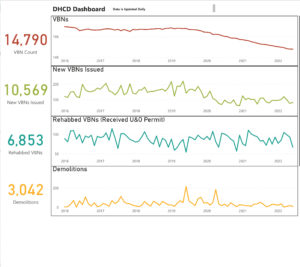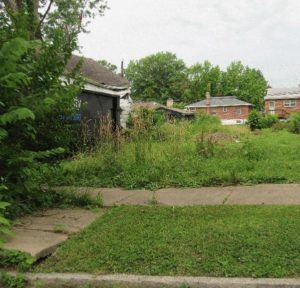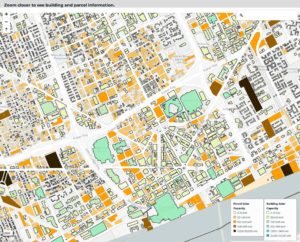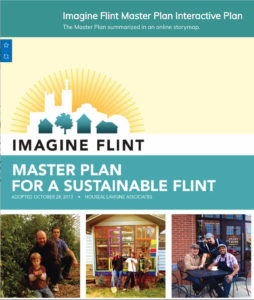Vacant Land Elements Examples by Type
Government
City of Baltimore
Baltimore’s Open Data Portal provides access to hundreds of datasets and interactive dashboards. The Vacant Building Dashboard shares data on number of vacant building notices, building rehabs, and demolitions. The data can be sorted and filtered by geographic bounds, time increments, and even “housing market typology.”
Read More »City of St. Louis Land Reutilization Authority
The ‘Mow to Own’ Program is allows residents who own an occupied residential or commercial property to purchase adjacent vacant lots for $125. Applications are submitted to the St. Louis Land Reutilization Authority (LRA) Board of Commissioners for review. Following approval, the successful applicant receives a deed to the property with a two-year maintenance lien.
Read More »City of Detroit
The Detroit Solar Map shows the potential solar energy for buildings and vacant lots within the Detroit city limits.
Read More »City of Flint
The repurposing of vacant properties is a central component of Imagine Flint. Recognizing that some areas of Flint cannot continue to exist as they do today, Flint residents have chosen to adapt and transform their neighborhoods and commercial corridors into areas where innovative practices, including green neighborhoods and the green…
Read More »- « Previous
- 1
- 2
- 3
The City of Danville zoning ordinance provides a number of useful tools for vacant lot development, including allowing urban gardening in most districts with a special permit, and creating a designation for districts where new development will infill parcels with vegetation and landscaping.
Read More »Open Baltimore is an online data portal that provides the public with access to hundreds of datasets and interactive dashboards, including a Vacant Building Dashboard. The Vacant Building Dashboard shares data on the number of vacant building notices, building rehabs, and demolitions. The data can be sorted and filtered by geographic bounds, time increments, and even “housing market typology.”
Read More »The Pittsburgh Land Recycling Handbook includes an analysis of distressed land in Pittsburgh, its impact, and the processes for managing it, as well as an operational plan to create a more coordinated and effective land recycling system.
Read More »The City of Camden zoning ordinance has many goals that align with vacant land reuse and revitalization, including “to conserve a corridor of natural open space (greenways) primarily along waterways within the City” and “to emphasize the need for a wide variety of open space and demonstrate its value as an essential community asset.
Read More »Rochester 2034 is a 15-year comprehensive plan to improve the community. Rochester’s population losses over the last several decades have left a legacy of vacancy – an urban challenge common to Rust Belt cities. Key takeaways in this work note that half of the vacant parcels in Rochester are owned by the City; all City-owned vacant lots are maintained at a ‘clean and green’ standard that exceeds many other cities…
Read More »This website assists residents in accessing or purchasing one of the 3,400 City-owned vacant lots in Rochester for temporary or permanent projects. Some lots are sold for large development projects, many are used as community gardens, and many more are waiting for their hidden potential to be realized. Featured is…
Read More »With the help of many dedicated citizens and professionals, the Department of City Development in Milwaukee has put together a handbook of creative reuse strategies for city-owned vacant land.
Read More »Buffalo’s Urban Homesteading Program enables eligible residents to purchase publicly owned land at a below market rate. Properties that are within designated Urban Renewal Areas are eligible for inclusion in the Urban Homestead Program at the sole discretion of the Office of Strategic Planning, provided that the property is not needed for public purposes and no qualified buyer is attempting to purchase the property.
Read More »New Orleans’ ‘Mow-to-Own’ Program invites homeowners adjacent to blighted lots to apply to take care of the empty spaces with the goal of purchasing them down the line.
Read More »In 2017, the City of Flint amended its zoning ordinance to create new designations, including a designation that recognizes green reuse as the dominant land use strategy in certain areas of the city.
Read More »